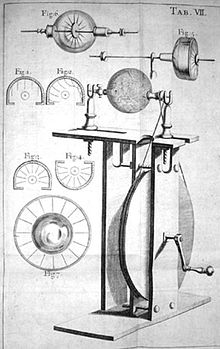Francis Hauksbee
- Francis Hauksbee
-

Générateur construit par Francis Hauksbee.
D'
après Physico-Mechanical Experiments,
2nde Ed.,
Londres 1719
Francis Hauksbee l'ancien (1666 - 1713), aussi appelé Francis Hawksbee, était un scientifique britannique du XVIIe siècle, membre de la Royal Society. Il est surtout connu pour ses travaux sur l'électricité et la répulsion électrostatique.
Vers 1705, Hauksbee découvre que s'il place une petite quantité de mercure dans le verre d'un générateur électrostatique de Otto von Guericke modifié par ses soins, et qu'il évacue l'air de celui-ci, lorsque la boule est chargée par frottement de la main, une lueur devient visible en plaçant sa main près de la boule, à l'extérieur. Cette lueur était suffisante pour permettre de lire. Cela semblait être similaire au feu de Saint-Elme.
Il découvre la lumière électrique en même temps que Pierre Polinière.
Cet effet est la base de la lampe néon et de la lampe à vapeur de mercure.
En 1709, il publie Expériences physico-mécaniques sur divers objets (Physico-Mechanical Experiments on Various Subjects), ouvrage dans lequel est résumé la majeure partie de son œuvre scientifique.
Liens externes
Catégories : - Physicien britannique
- Physicien du XVIIIe siècle
- Naissance en 1666
- Décès en 1713
Wikimedia Foundation.
2010.
Contenu soumis à la licence CC-BY-SA. Source : Article Francis Hauksbee de Wikipédia en français (auteurs)
Regardez d'autres dictionnaires:
Francis Hauksbee — Hauksbee Generator, aus Physico Mechanical Experiments, 2. Aufl., London 1719 Francis Hauksbee der Ältere (auch Hawksbee ) (* um 1666, wahrscheinlich in Colchester; † im April/Mai 1713 in London) war ein britischer Wissenschaftler, der auch seit… … Deutsch Wikipedia
Francis Hauksbee (scientist) — Francis Hauksbee the elder (1666 1713), also known as Francis Hawksbee, was an eighteenth century British scientist, and a member of the Royal Society. He is best known for his work on Electricity and electrostatic repulsion. By 1705, Hauksbee… … Wikipedia
Hauksbee — Generator, aus Physico Mechanical Experiments, 2. Aufl., London 1719 Francis Hauksbee der Ältere (auch Hawksbee ) (* um 1666, wahrscheinlich in Colchester; † im April/Mai 1713 in London) war ein britischer Wissenschaftler, der auch seit 1705… … Deutsch Wikipedia
Hauksbee — may refer to: *Francis Hauksbee (scientist), 1666 1713. *Mrs. Hauksbee, a fictional character in many stories by Rudyard Kipling … Wikipedia
Hauksbee, Francis, The Younger — ▪ British scientist born 1687 died Jan. 11, 1763 English instrument maker, scientist, and lecturer. He may have been a son of Francis Hauksbee the Elder. As early as about 1714 Hauksbee began giving lectures, with demonstrating… … Universalium
Hauksbee — (Hawksbee, spr. Hahksbi), Francis, war englischer Naturforscher u. starb in der Mitte des 18. Jahrh.; machte Entdeckungen, welche für die später aufgestellte Theorie der Elektricität von Wichtigkeit sind, u. schr.: Physisch mechanische Versuche,… … Pierer's Universal-Lexikon
Hauksbee — [ hɔːksbɪ], Hawksbee [ hɔːksbɪ], Francis, englischer Physiker und Instrumentenbauer, * Colchester um 1666, ✝ London April 1713; Mitglied der Royal Society und deren Experimentator. Er führte wichtige Versuche zur Elektrolumineszenz (mit… … Universal-Lexikon
Hauksbee, Francis, The Elder — ▪ British scientist Hauksbee also spelled Hawksbee died c. 1713 self educated English scientist and eclectic experimentalist whose discoveries came too early for contemporary appreciation of their significance. Hauksbee determined… … Universalium
Hauksbee , Francis — (c. 1670–1713) English physicist Hauksbee, a student of Robert Boyle, conducted numerous experiments on a wide range of topics. They are fully described in his Physico Mechanical Experiments (1709). He worked as demonstrator at the Royal Society… … Scientists
Barometric light — is a name for the light that is emitted by a mercury filled barometer tube when the tube is shaken. The discovery of this phenomenon in 1675 revealed the possibility of electric lighting. The phenomenon and its explanation The earliest barometers … Wikipedia

